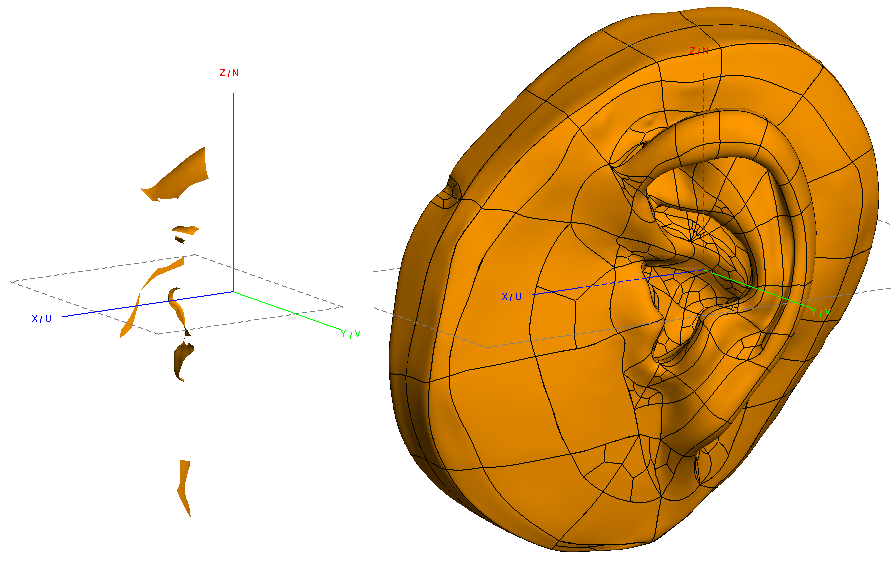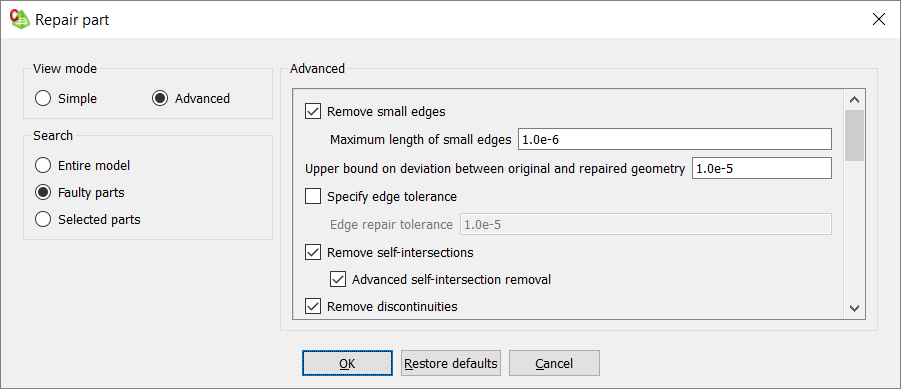Repair Part
The Repair part tool heals a body in an attempt to create a valid geometry part.
- topology with an invalid sense
- invalid edge and vertex tolerances
- invalid geometry
- self-intersecting geometry
- non-G11 geometry
- missing edge or vertex geometry
- missing vertices
- vertices not on curve of edge
- edges and vertices not on surface of face

Figure 1. The imported model containing faults (left) and the result of the Repair part tool on the model (right).

Advanced settings
- Remove small edges
- Edges are removed whose arc length is less than the Maximum length of small edges.
- Maximum length of small edges
- Edges are removed with arc lengths of edges less than the Maximum length of small edges.
- Upper bound on deviation between original and repaired geometry
- The tolerance for repairing the part.
- Specify edge tolerance
- To be more consistent with the surfaces in the model, it may be the case that the distance changes in the surface geometry are more important than the exact locations of the edges. If this option is selected, a more lenient tolerance for edge geometry can be specified for Edge repair tolerance.
- Edge repair tolerance
- An optional tolerance that is specified to permit greater latitude in repairing edges.
- Remove self-intersections
- When a surface contains self-intersections located outside its face boundaries, then this portion of the surface will be removed by splitting the surface. This may result in the face being split into multiple faces.
- Advanced self-intersection removal
- A more in-depth algorithm is used to fix self-intersecting surfaces.
- Remove discontinuities
- Surface discontinuities are removed. If the discontinuity has a change in the tangent of less than the angular tolerance, the discontinuity will be smoothed. If the change in tangent is greater than Angular tolerance for geometry smoothening (degrees), the face or edge will be split at the surface’s discontinuity. The same applies to curve G1 discontinuities.
- Angular tolerance for geometry smoothening (degrees)
- The tangent change angle in degrees above which G1 discontinuities are removed by splitting topology rather than smoothening the geometry.
- Suppress surface modifications
- Surface geometry is preserved and repairs are confined to repairing face boundaries as far as possible.
- Repair bad face-face errors
- Attempt to repair face-face collisions in the body.
- Repair surfaces by simplifying to blends
- Surfaces are cleaned by simplifying to blends.
- Simplify B-surfaces to analytic / swept / spun surfaces
- Any B-surfaces are simplified where possible to planes, cylinders, cones, spheres or tori where possible.
- Simplify swept / spun surfaces to analytic surfaces
- Any swept or spun surfaces are simplified to planes, cylinders, cones, spheres or tori.
- Simplify B-curves to analytic curves
- Any B-curves are simplified to lines, circles or ellipses.
- Simplify rational B-geometry to non-rational geometry
- Any rational B-surfaces are simplified to non-rational B-surfaces. Non-rational B-surfaces have fewer degrees of freedom than rational B-surfaces.
- Reduce high-degree and trim large B-geometry
- Any high-degree B-surfaces are trimmed or simplified to cubic B-surfaces.
- Simplify to constant U or V curves
- The tool will attempt to simplify SP-curves2 to be constant in one parameter (U or V).
- Merge multiple segments
- The tool will attempt to merge multiple curve segments into a single segment.
- Operating precision (tolerance)
- The tolerance for replacement geometry.
- Specify edge tolerance
- To be more consistent with the surfaces in the model, it may be the case that the distance changes in the surface geometry are more important than the exact locations of the edges. If this option is selected, a more lenient tolerance for edge geometry can be specified for Edge repair tolerance.
- Edge repair tolerance
- This is an optional tolerance to permit greater latitude in repairing edges.
- Convert surfaces to blend surfaces
- The surfaces are cleaned by attempting to simplify to blends.
- Constrain surface normals along smooth edges
- The tool will attempt to ensure that smooth edges will remain smooth3 since the maximum deviation between the normals for these faces will be equal to the surface normal tolerance.
- Surface normal tolerance (degrees)
- The angular tolerance for constraining surface normals in degrees.